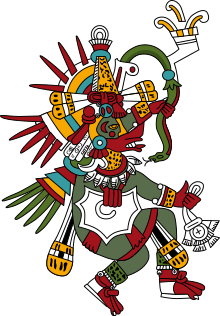Tonantzin
In classical Aztec mythology and among present-day Nahuas, Tonantzin (Classical Nahuatl: Tonāntzin [toˈnáːn.tsin])[1] is the title of an Aztec mother goddess.
Aspects
Such Goddesses as "Mother Earth", the "Goddess of Sustenance", "Honored Grandmother", "Snake", "Bringer of Maize" and "Mother of Corn" can all be called Tonantzin, as it is an honorific title comparable to "Our Lady" or "Our Great Mother". Other indigenous (Nahuatl) names include Chicōmexōchitl [tʃikˌoːmeˈʃóːtʃitɬ] (literally "Seven Flower") and Chālchiuhcihuātl [ˌtʃaːɬtʃiʍˈsíwaːtɬ] (literally "Emerald/Jade Woman"). A "Tonāntzin" was honored during the movable feast of Xōchilhuitl [ʃoːˈtʃíɬwitɬ]. Some have claimed that upon the apparition of Our Lady of Guadalupe in the hill of Tepeyac where Tonantzin's temple had been destroyed by the Spanish priests, the natives recognized Our Lady of Guadalupe as Tonantzin Coatlaxopeuh (Meaning "Our Lady" who emerges from the region of light like the Eagle from fire).
Alleged syncretism
Mexico City's 17th-century Basilica of Guadalupe—built in honor of the Blessed Virgin and perhaps Mexico's most important religious building—was constructed at the base of the hill of Tepeyac, believed to be a site used for pre-Columbian worship of Tonantzin. It has been asserted that the word Guadalupe in this appellation may derive from Coatlaxopeuh, meaning “the one who crushes the serpent”, and perhaps referring to Quetzalcoatl. The name really came about because the Spanish remembered the Virgin of Guadalupe in Extremadura, Spain, giving this apparition the same name as the one from their homeland.
Modern usage
Tonantzin is sometimes used as a female given name; Native Californian actress Tonantzin Carmelo is an example. Tona, Tonzi, Toni, Nantzin, and Nancy are possible nicknames.
In the comic series Love and Rockets by Gilbert Hernandez and Jaime Hernandez, Tonantzin is the name of a central character in Gilbert's world of Palomar. The character is often linked to the Aztec goddess.
References
- Composed of to- "our" + nān "mother" + -tzin "(honorific suffix)". When addressing Tonantzin directly, males use the suffixed vocative form Tonāntziné [toˌnaːntsinˈé] while females use the unsuffixed vocative form Tonāntzín [tonaːnˈtsín].
- González, Ondina E. and Justo L. González, Christianity in Latin America: a history, p. 59, Cambridge University Press, 2008
Readings in classic Nahuatl http://pages.ucsd.edu/~dkjordan/nahuatl/nican/NicanMopohua.html
